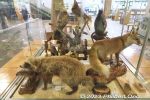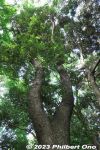 Image search results - "observation" Image search results - "observation" |

Toki Messe's tower is the city's tallest building at 140 meters.
|
|

Toki Messe is a multipurpose complex which includes a convention center, exhibition hall, hotel and office tower (the city's tallest building), art museum, and an observation deck on the 31st floor.
|
|

The observation deck is about 125 meters above the ground. The tallest building along the Sea of Japan coast. Fine view of Shinano River.
|
|

In the foreground is Bandaibashi Bridge, spanning Shinano River.
|
|
|
|
|

Too hazy to see Sado island.
|
|

Toward the mouth of Shinano River.
|
|
|
|

Ferry to Sado island.
|
|
|
|

Fishing boats
|
|
|
|

Central Niigata
|
|

Ticket gate and entrance to Hitsujigaoka Observation Hill (Hitsujigaoka Tembodai). 500 yen admission is charged so someone from the ticket office boarded our bus to collect admission fees.
|
|

Approaching Hitsujigaoka Observation Hill. The place is open every day from 8:30 am to 6 pm or 7 pm during spring and summer. Slightly shorter hours during winter (Oct.-April).
|
|

The place has a large parking lot and restaurant, shops, and wedding chapels. A little tourist village has formed over the years since the Hitsujigaoka Observation Hill opened in 1959.
|
|

Hitsujigaoka Observation Hill is accessible by a 10-min. bus ride from Fukuzumi Station (Toho subway line). See the famous statue of William Clark on the fringe beyond the parking lot.
|
|

While there, you will likely hear this bell being rung constantly. The place is managed by the Sapporo Tourist Association.
|
|

Clark Bon Voyage Bell クラーク旅立ちの鐘
|
|

Most postcards of Hitsujigaoka Observation Hill show only this famous statue. So I had no idea that there was also a little tourist village.
|
|

An endless line of people taking pictures and posing in front of the statue.
|
|

Hitsujigaoka Observation Hill's lookout deck.
|
|

"Boys, Be Ambitious" This famous statue of Dr. William Clark was built in 1976 to mark Dr. Clark's 100th anniversary of his coming to Hokkaido, the 100th anniversary of Hokkaido University's founding, and the USA bicentennial.
|
|

Dr. William S. Clark (1826-1886) was a professor from Massachusetts. The statue was made by a Japanese sculpturer and sponsored by the Sapporo Tourist Association. Hokkaido University has a bust of Dr. Clark which is also popular among tourists.
|
|

Clark came to Hokkaido for 8 months during 1876 to 1877 as a founding vice president of Sapporo Agricultural College (now Hokkaido University). When he departed, he supposedly said, "Boys, be ambitious!" to the students seeing him off.
|
|

The low hill overlooks Sapporo from the southeast.
|
|

Sapporo Dome can be seen on the right. It is near Fukuzumi Station.
|
|

Another prop for photos. "I love Sapporo!"
|
|

Hitsujigaoka means Sheep Hill, and it actually has sheep.
|
|

Yujiro Song Monument for a Sapporo song called, "Koi no Machi Sapporo" (恋の町札幌) sung by Ishihara Yujiro whose bust is on the right. Built in 1991.
|
|

Hokkaido Nippon Ham Fighters baseball team monument marking the team's founding. Built in 2004. 北海道日本ハムファイターズ誕生記念碑
|
|

The monument has handprints and autographs of the players.
|
|

Handprint and autograph of Tsuyoshi Shinjo who was the team's most famous player.
|
|

Clark Chapel on the left, and on the right is the Sapporo Snow Festival Museum which opened in 2001. It used to be a wedding chapel. さっぽろ雪まつり資料館
|
|

The Sapporo Snow Festival Museum has display panels of all the past Sapporo Snow Festivals, dating from 1950.
|
|

Panel for the 33rd Sapporo Snow Festival in 1982 which featured Iolani Palace of Honolulu, Hawaii.
|
|

Snow Festival poster
|
|

The museum also has rooms showing scale models of the giant snow sculptures built in the past. These scale models were made when the respective snow sculpture was being designed.
|
|

Scale model of Hawaii's Iolani Palace made of wood, painted white. Built for the 33rd Sapporo Snow Festival in 1982.
|
|

Scale model of the Iolani Palace made of wood, painted white. Built for the 33rd Sapporo Snow Festival in 1982. The palace is in Honolulu, Hawaii, built by King David Kalakaua in 1882.
|
|

Top view of Iolani Palace scale model.
|
|
|
|

Sculpture of Commodore Perry's visit to Japan (2003).
|
|

More scale models in this room.
|
|

Horyuji temple, Nara
|
|

Palace in Thailand (2007)
|
|

Left is the capitol building in Norway (2005), and on the right is Flinders Street Station in Australia (2006).
|
|

Concert Gebouw, Holland (2000)
|
|

Salzburg Cathedral, Austria (1996)
|
|

Munich National Museum, Germany (1997)
|
|

London St. Paul's Cathedral, UK (1998)
|
|

Schloss Linderhof castle, Germany (1995)
|
|

Tools used to carve the snow sculptures.
|
|

Sapporo Snow Festival memorabalia.
|
|

Sapporo Snow Festival pins
|
|

Sapporo Snow Festival postcards
|
|

Snow Festival book
|
|

Sheep house
|
|

Inside sheep house
|
|

On the left is the Rest House with a restaurant (built in 1985), and on the right is the Austrian Pavilion moved here in 1972 after the Sapporo Winter Olympics. It houses gift shops.
|
|

Mon-chi-chi with a melon cap.
|
|

Wedding chapel. Not for tourists, but you can take the elevator to the top floor for fine views of the surrounding area.
|
|

Girl and Sheep sculpture at Hitsujigaoka Observation Hill, Sapporo, Hokkaido
|
|
|
|

Kitamoto Nature Observation Park is spread over 26.7 hectares and home to a variety of plants and animals, including over 1,700 species of insects and 160 species of wild birds. Lots of marshland where birds can nest. Walking paths are provided for visitors. The park includes a nature study center, a library, and guided tours on weekends.
|
|

Park entrance. The park is open to the public from 9:00 am to 5:00 pm (until 7:30 pm on weekends and mid-summer.) Closed Mon. unless it's a national holiday. Free admission. Parking available. 15 min. by bus from JR Kitamoto Station (JR Takasaki LineAddress: 5-200 Arai, Kitamoto, Saitama
埼玉県北本市荒井5-200
埼玉県自然学習センター
|
|
|

Free guided tours cover only a small part of the park. If you want to explore the entire park, go on your own. The park opened in July 1992 by Saitama Prefecture.
|
|

Saitama Nature Study Center is a visitor's center with park staff, park maps, a small library, nature exhibits, meeting rooms, and park offices. Open 9:00 a.m. -5:00 p.m. (Till 7:30 pm on weekends and national holidays.) Guided tours start inside.
|
|

Inside Saitama Nature Study Center with nature exhibits.
|
|

Stuffed wild animals in Saitama Nature Study Center.
|
|

Raccoon, fox, and weasel.
|
|

Northern goshawk, juvenile.
|
|

Chinese peacock butterfly. カラスアゲハ
|
|

In front of the Saitama Nature Study Center is china root or Smilax china. サルトリイバラ
|
|

Guided tour of the park. About an hour long.
|
|
|
|

Boardwalk across the marsh.
|
|
|

Boardwalk and reeds where birds and fish can live.
|
|
|
|

Marshland and reeds provide habitats for nesting birds. We saw Little Grebes nesting here.
|
|

Heron.
|
|

Giant dogwood is a tall flowering plant. ミズキ
|
|

Giant dogwood is nicknamed "Wedding Cake Tree" due to the multi-tiered trunk and branches. ミズキ(Mizuki)
|
|

Not allowed to pick any plants.
|
|

Giant dogwood flowers. ミズキ(Mizuki)
|
|

Nature trail.
|
|
|
|

Small edible fruit of this flowering plant. Lonicera gracilipes Miq. var. gracilipes ヤマウグイスカグラ(山鶯神楽)
|
|

Endangered flower species named golden orchid. Vulnerable (VU). キンラン(金蘭)
|
|

Endangered flower species named golden orchid. Status is "Vulnerable (VU)." キンラン(金蘭)
|
|

Nice boardwalk across the marsh where we could see and observe birds and water plants. Our guide brought a binoculars which we used to spot bird nests.
|
|

Dainty flower.
|
|

Our guide showed us how to create a wind instrument using wild leaves like this. Roll it up into a cylinder and blow.
|
|

Making sounds with a leaf. Loud, piercing sound.
|
|

Mini strawberries. Hardly any flavor.
|
|

Mulberry tree whose bark is used to make washi paper.
|
|

Evergreen tree named Castanopsis. Leaves are green on the top, but brown on the underside. Produces acorns. スダジイ(すだ椎 Castanopsis sieboldii subsp. sieboldii)
|
|

Evergreen tree named Castanopsis. Leaves are green on the top, but brown on the underside. Produces acorns. スダジイ(すだ椎 Castanopsis sieboldii subsp. sieboldii)
|
|

Kitamoto has other walking trails. Looks pretty during cherry blossom season.
|
|
|
|
|
|
|